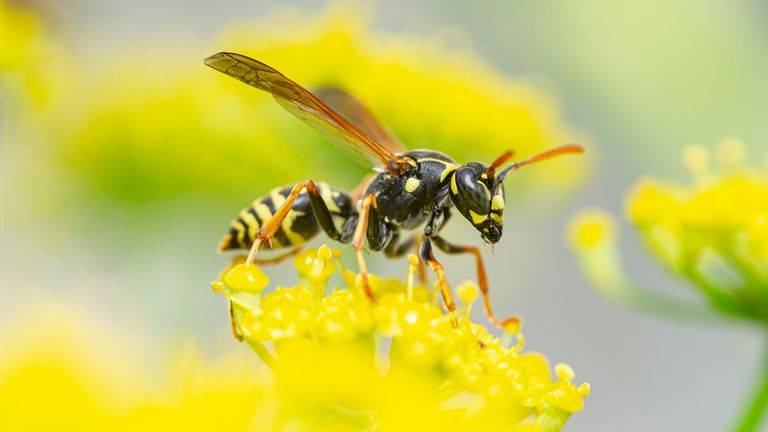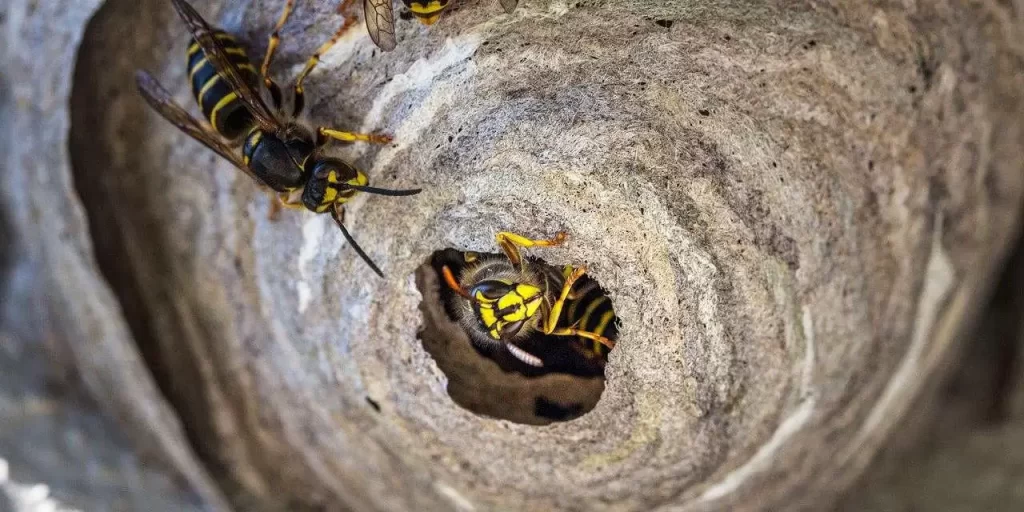Introduction:
Wasps, with their distinctive appearance and behaviors, have long fascinated both scientists and curious observers. In this comprehensive article, we delve into the world of wasps, exploring their lifespans, colony formation, and intriguing survival strategies. Discover the secrets of these remarkable insects and gain a deeper understanding of their life cycle. Join us as we uncover the mysteries of how wasps start colonies, form nests, and thrive in various environments.
How Long Do Wasps Live?
Wasps, with their distinctive appearance and behaviors, have a limited lifespan compared to other insects. The lifespan of a wasp can vary depending on its caste within the colony. There are three primary castes: worker wasps, drone wasps, and queen wasps.

Worker wasps, responsible for various tasks such as foraging, nest construction, and caring for larvae, have the shortest lifespan. On average, worker wasps live for about 12 to 22 days. Their brief existence is filled with tireless work and selfless dedication to the survival and growth of the colony. During the summer months, when food sources are abundant, worker wasps maximize their efforts to ensure the nourishment and development of their offspring.
Drone wasps, whose primary role is to mate with the queen, have an even shorter lifespan. They typically live for about 12 to 25 days. Once the mating season concludes, drone wasps fulfill their sole reproductive purpose and usually die shortly afterward.
In contrast, queen wasps have a relatively longer lifespan. After emerging from hibernation during the spring, the queen establishes a new colony and begins laying eggs. The queen can live for several months, and in some cases, up to a year. During her lifetime, she can produce thousands of offspring, ensuring the continuity of the colony.
The lifespan of a wasp is influenced by various factors such as environmental conditions, availability of resources, predation, and natural hazards. These factors, combined with the intense activity levels and demanding tasks performed by worker and drone wasps, contribute to their relatively short lives.
Understanding the lifespan of wasps provides valuable insights into their role in ecosystems and the importance of their reproductive strategies. Despite their short lives, wasps play significant roles in pollination, pest control, and maintaining ecological balance.
The Worker Wasp’s Lifespan:
Worker wasps are the backbone of a wasp colony. They tirelessly perform various tasks necessary for the survival and growth of the colony, including foraging for food, building and maintaining the nest, caring for larvae, and defending the colony against threats.
The lifespan of a worker wasp is relatively short, lasting around 12 to 22 days on average. This limited lifespan is due to the demanding nature of their tasks and the physical toll it takes on their bodies. The intense activity levels, exposure to environmental stressors, and the need to allocate energy resources for nest maintenance and caring for larvae contribute to their accelerated aging process.
During the summer months, when food sources are abundant, worker wasps intensify their foraging efforts to collect nectar, fruit juices, and other sources of carbohydrates. They also hunt insects and spiders to provide protein for the developing larvae. The constant search for food and the strenuous physical labor involved in nest construction and maintenance contribute to the relatively short lifespan of worker wasps.
As the colony grows, the workload of the workers increases, leading to further wear and tear on their bodies. Over time, the accumulation of physical stress, coupled with the physiological changes associated with aging, leads to a decline in their overall health and eventual death.
Despite their short lives, worker wasps are essential for the survival of the colony. Their selfless dedication and tireless efforts ensure the continuity and success of the wasp population.
The Drone Wasp’s Lifespan:
Drone wasps, unlike worker wasps, have a singular purpose in the colony: to mate with the queen. Their lifespan is even shorter compared to workers, typically ranging from 12 to 25 days.
During the mating season, drone wasps emerge from the nest and venture out in search of potential mates. They are equipped with larger eyes to help them locate receptive queens. Once a drone successfully mates with a queen,
its reproductive role is fulfilled. After mating, the drone wasp’s lifespan comes to an end, and it usually dies shortly afterward.
Unlike worker wasps, drones do not engage in tasks such as foraging or nest construction. Their primary focus is on finding and mating with queens from their own or neighboring colonies. Drones possess larger bodies and longer antennae, enabling them to detect and pursue queens in flight.
The limited lifespan of drone wasps is primarily attributed to their reproductive function. Once they have successfully mated, their biological purpose has been fulfilled, and their continued existence is no longer necessary for the colony. Without the ongoing need for reproduction, drones gradually decline in number as the mating season concludes, and they eventually die off.
The Queen Wasp’s Lifespan:
The queen wasp, as the primary reproductive member of the colony, has a longer lifespan compared to worker and drone wasps. After emerging from hibernation during the spring, the queen sets out to establish a new colony. Her longevity allows her to lay a substantial number of eggs, ensuring the growth and survival of the colony.
The exact lifespan of a queen wasp can vary depending on factors such as environmental conditions and available resources. On average, queen wasps live for several months, and in some cases, they can live up to a year or longer. During this time, the queen focuses on producing offspring, laying eggs, and maintaining the structure and stability of the colony.

The queen wasp begins by constructing the initial nest, usually in a protected area such as a tree cavity, eaves, or attics. She forms the nest by chewing wood fibers and mixing them with her saliva, creating a papery substance that serves as the foundation for the growing colony. Once the nest is established, the queen starts laying eggs and continues to do so throughout her lifespan.
The ability of the queen wasp to produce thousands of offspring is crucial for the survival and expansion of the colony. Her reproductive role ensures the next generation of workers and reproductive wasps, maintaining the population and genetic diversity within the colony.
As autumn approaches and the mating season begins, the queen’s focus shifts toward producing new queens and male drones. These reproductive wasps will mate and leave the nest in search of suitable overwintering sites. The founding queen, along with the old workers, dies off during the winter, while the newly mated queens enter a state of hibernation, ready to establish their own colonies in the following spring.
In conclusion, the lifespans of wasps vary depending on their caste within the colony. Worker wasps, with their demanding tasks and intense activity levels, have a relatively short lifespan of around 12 to 22 days. Drone wasps, whose sole purpose is to mate with the queen, live for approximately 12 to 25 days. Queen wasps, responsible for reproduction and colony growth, have a longer lifespan, typically ranging from several months to a year or longer. Understanding the lifespan of each caste provides insights into the intricate social structure and reproductive strategies of wasp colonies.
The Wasp Life Cycle:
The life cycle of a wasp encompasses distinct stages, each marked by specific biological changes and behaviors. Understanding the different phases of the wasp life cycle provides valuable insights into their development, reproduction, and colony dynamics.
Egg Stage: The life cycle of a wasp begins when the queen wasp lays eggs. These eggs are typically small, oval-shaped, and attached to the inner walls of the nest. The queen carefully selects suitable locations within the nest to ensure the eggs’ safety and optimal conditions for development. The number of eggs laid by the queen can vary depending on the species, but it can range from a few dozen to several hundred.
Larval Stage: After a period of incubation, the eggs hatch, giving rise to the larval stage. Wasp larvae are legless and grub-like in appearance. They are entirely dependent on the worker wasps for nourishment and care. The worker wasps feed the larvae with a protein-rich diet consisting of insects and spiders. The larvae grow rapidly during this stage, undergoing several molts as they increase in size.
Pupal Stage: Once the larvae have completed their growth and development, they enter the pupal stage. During this phase, the larvae spin a cocoon around themselves, transforming into pupae. Inside the cocoon, significant physiological changes occur as the larvae undergo metamorphosis. The pupal stage is a crucial period of transformation, during which the internal structures and features of the adult wasp develop.
Adult Stage: After the completion of metamorphosis, adult wasps emerge from the pupal stage. The newly emerged wasps have soft bodies and are initially pale in color. As they undergo sclerotization, a process in which their exoskeleton hardens and darkens, they acquire the characteristic appearance of adult wasps. At this stage, their wings fully expand, allowing them to fly, and their reproductive organs become functional.
The newly emerged wasps are primarily worker wasps. Their immediate tasks include nest maintenance, caring for the developing larvae, and foraging for food. As the colony expands, more workers are produced to support the growing demands of the colony.
During the summer months, the colony reaches its peak population, and reproductive wasps, including new queens and male drones, begin to emerge. These reproductive wasps have a distinct role in the colony’s life cycle. The queens will mate with drones from other colonies, ensuring genetic diversity, while the drones will seek out queens for mating. Once mating is complete, the cycle begins again as the mated queens establish their own colonies and continue the life cycle.
It is important to note that the timing and duration of each stage of the wasp life cycle can vary depending on factors such as species, environmental conditions, and resource availability. The life cycle of wasps is intricately linked to the survival and success of the colony, with each stage playing a crucial role in the overall dynamics and reproductive strategies of these remarkable insects.
How Do Wasps Start a Colony?
The process of starting a wasp colony begins with a mated queen. After emerging from hibernation during the spring, the queen searches for a suitable location to establish her colony. She looks for sheltered areas such as tree cavities, attics, or eaves that provide protection from the elements and potential predators.
Once a suitable location is found, the queen begins constructing the nest. Wasp nests are typically made of a paper-like material created by chewing wood fibers and mixing them with saliva. This papery substance is then shaped into hexagonal cells, forming the familiar comb-like structure of the nest.
During the initial stages of nest construction, the queen lays a few eggs within the cells. She then incubates and cares for the developing larvae until they reach the pupal stage. As the first batch of workers emerges from the pupae, they take over the responsibilities of nest expansion, foraging for food, and caring for subsequent generations.
How Do Wasp Nests Form?
Wasp nests are fascinating architectural marvels created through the collective efforts of the colony members. The process of nest formation involves a combination of intricate behaviors and specialized anatomical adaptations.
The construction of a wasp nest begins with the queen wasp. Using her powerful mandibles, she chews and masticates wood fibers, mixing them with her saliva. This mixture forms a pulp-like substance that can be molded and shaped into cells. The queen carefully attaches these cells to form the initial structure of the nest.
As the nest expands, worker wasps join in the construction process. They collect wood fibers by scraping surfaces like fences, logs, or dead plants. The collected fibers are then chewed and mixed with saliva to create additional pulp for nest building. The workers use their mandibles to shape the pulp into cells and attach them to the existing nest structure.
The cells in a wasp nest serve various purposes. Some cells are used for rearing larvae, while others are designated for food storage or as sheltered areas for the queen. The nest structure typically consists of multiple layers of hexagonal cells arranged in a comb-like pattern.
Throughout the construction process, wasps maintain a cohesive and organized colony structure. Chemical signals, such as pheromones, play a crucial role in communication among colony members, allowing them to coordinate their efforts and ensure the successful formation and expansion of the nest.
What Are the Time Sequences of a Colony?
The life of a wasp colony follows a sequence of distinct stages and activities, each playing a vital role in the colony’s survival and success. The time sequences within a colony can vary depending on environmental conditions, species, and available resources.
Spring: The colony cycle usually begins in the spring when the mated queen emerges from hibernation. She starts by establishing a new nest and laying the first eggs. This period is critical for nest construction, early population growth, and the development of worker wasps.
Summer: During the summer months, the colony reaches its peak population. The queen continues to lay eggs, and the number of worker wasps increases to support the colony’s needs. The workers are responsible for foraging, nest maintenance, caring for larvae, and defending the colony. This period is characterized by intense activity as the colony maximizes its efforts to gather resources and ensure the survival of the next generation.
Late Summer/Autumn: As autumn approaches, the dynamics of the colony change. The queen begins producing new queens and male drones. These reproductive wasps will mate and leave the nest to find suitable overwintering sites. The founding queen and the old workers die off during the winter, while the newly mated queens enter a state of hibernation, ready to establish their own colonies in the following spring.

Wasps Can Die of Loneliness?
Wasps are social insects that thrive in the presence of their colony members. They rely on intricate communication systems, primarily through chemical signals or pheromones, to maintain the cohesion and efficiency of the colony. As such, isolation and loneliness can have significant adverse effects on individual wasps.
Worker wasps, in particular, are highly social creatures. They work together in harmony to achieve common goals, such as foraging for food, caring for the brood, and defending the nest. The pheromones they release convey important information about food sources, danger, and the overall state of the colony. This constant communication fosters a sense of community and purpose among the workers.
However, in some cases, individual wasps may become separated from the colony due to accidents or disturbances. These isolated wasps are cut off from the pheromone signals that guide and inform their behaviors. As a result, they may struggle to find food, defend themselves against predators, or navigate back to the nest. Without the support and cooperation of the colony, their chances of survival significantly decrease.
Isolated worker wasps are also more vulnerable to predators, as they lack the collective strength and defensive strategies employed by a united colony. They become easier targets for predators like birds, spiders, and other insects. Loneliness can be a life-threatening condition for worker wasps, as their short lifespan and reliance on the colony’s resources make them ill-equipped to survive on their own.
On the other hand, reproductive wasps, such as queen wasps and male drones, are less affected by loneliness. They have more solitary behaviors, especially during the mating season when they venture away from the nest to find mates from other colonies. However, even for these wasps, isolation outside the mating period can still lead to decreased chances of successful reproduction and colony establishment.
In conclusion, wasps are highly social insects that rely on cooperation and communication within their colony for survival and success. Loneliness can be detrimental to worker wasps, who depend on the support of the colony for food, protection, and navigation. Isolated workers face numerous challenges and have limited chances of survival. This aspect of the wasp’s behavior underscores the significance of their social structure and the essential role played by each member in the functioning and perpetuation of the colony.
How Long Can Wasps Live Indoors?
Wasps, being adaptable insects, can survive in various environments, including indoors. When wasps find their way inside a building, they may attempt to establish a nest or seek food and shelter. However, their survival indoors is often limited, as the conditions may not fully support their natural needs.
The lifespan of a wasp living indoors can vary depending on factors such as the availability of food, access to water, temperature, and the presence of potential threats or predators. Without access to their usual food sources, such as nectar, insects, and spiders, wasps may struggle to find suitable nutrition indoors.
In some cases, wasps may scavenge for food scraps or sweet substances like fruits, sugary beverages, or leftover food. However, these sources may not provide all the necessary nutrients for their survival. Additionally, indoor environments are not conducive to the formation of new nests, reducing their ability to expand the colony and reproduce.
The absence of natural materials, like wood and plant fibers, can hinder the wasp’s ability to build a proper nest indoors. As a result, they may create small, temporary nests in hidden corners or crevices, but these are unlikely to thrive or survive for extended periods.
Furthermore, indoor conditions can expose wasps to various hazards and dangers, including chemicals, traps, and human interference. Pest control measures commonly used indoors may pose significant threats to wasp populations.
Overall, the lifespan of wasps living
indoors is typically shorter compared to their lifespan in their natural outdoor habitats. While it is challenging to determine an exact timeframe, wasps living indoors may survive for a few weeks to a couple of months, depending on the availability of resources and the conditions provided.
It’s important to note that the presence of wasps indoors can be a nuisance and potentially pose a threat to human inhabitants. Wasps are known for their defensive behavior and can sting when they feel threatened. This is why it is crucial to address any indoor wasp infestations promptly and seek professional assistance to safely remove them from the premises.
The Short Lives of Wasps and Their Colonies:
Wasps have relatively short lifespans compared to many other insects. The duration of a wasp’s life can vary depending on factors such as species, environmental conditions, and their role within the colony.
Worker wasps, which constitute the majority of the colony population, typically live for a few weeks to a few months. Their primary responsibilities include nest maintenance, foraging for food, and caring for the larvae. The demanding nature of their tasks, coupled with the challenges they face in locating food and defending the nest, contribute to their relatively short lifespan.
The queen wasp, however, has a longer lifespan compared to the workers. Queen wasps can live for several months or even up to a year, depending on the species. Their main role is reproduction, and they are responsible for laying eggs and founding new colonies. The extended lifespan of the queen allows for multiple reproductive cycles and the establishment of successive generations.
Male drones, which emerge later in the colony’s development, have the shortest lifespan among the three castes. Their sole purpose is to mate with the new queens from other colonies. Once mating is complete, the male drones typically die shortly afterward.
The lifespan of a wasp colony as a whole is also relatively short. In temperate regions, colonies are active during the warmer months, typically from spring to early autumn. As the colder weather approaches, the colony starts to decline. The founding queen and the old workers die off, and the newly mated queens seek shelter to overwinter and establish new colonies the following year.
The short lives of wasps and their colonies reflect the seasonal nature of their life cycles and the strategies they employ to ensure the survival of future generations. The combination of rapid development, intense activity, and eventual decline is a characteristic feature of wasp colonies.
How Long Can a Wasp Survive Without Food/Water?
Wasps, like all living organisms, require food and water to sustain their physiological functions and maintain their energy levels. However, they have developed adaptations that allow them to survive for a certain period without access to these essential resources.
The exact duration that a wasp can survive without food or water depends on several factors, including environmental conditions, the wasp’s age and health, and the availability of stored resources within the colony.
Typically, wasps can survive for a few days to a couple of weeks without food. During this time, they can rely on stored energy reserves in their bodies, primarily in the form of fat reserves. These reserves are built up during periods of ample food availability, such as the early stages of colony development or times when foraging is productive.
Water, on the other hand, is crucial for wasp survival as it is involved in various physiological processes. While wasps can tolerate brief periods without direct access to water, their survival is significantly compromised if they are deprived of it for an extended period. In hot and arid conditions, the need for water becomes even more critical.
It is worth noting that wasps can source water from alternative sources such as moist soil, dew, or even by collecting condensation on surfaces. They are also known to scavenge water-rich substances, such
as fruits, nectar, or sap. These alternative sources can help sustain their water requirements to some extent when natural water sources are scarce.
However, it’s important to emphasize that the ability of wasps to survive without food or water is limited. Their bodies are finely tuned for efficient energy utilization, and prolonged deprivation can lead to weakened physiological functions and ultimately death.
Additionally, the survival duration without food or water can vary among the different castes of wasps. Worker wasps, being highly active and responsible for tasks such as foraging and nest maintenance, have higher energy demands and may have a shorter survival time without food or water compared to the queen or drones.
In conclusion, while wasps have some adaptations that allow them to survive for a limited time without food or water, their ability to sustain themselves is ultimately dependent on the availability of these resources. Deprivation of food and water can lead to weakened physiological functions, reduced activity, and eventually, death. It is crucial for wasps to have access to these essential resources to ensure their survival and the functioning of the colony.

